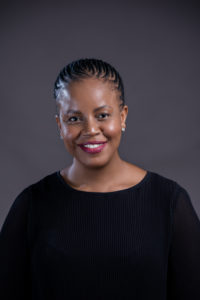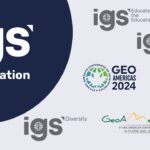No contribution is too small when it comes to getting involved in the IGS. That’s according to Jabulile Msiza, an IGS council member and vice chair of the Technical Committee on Barrier Systems. Here, she shares her highlights for the year ahead and why she thinks education is key.

Please tell us a bit about your involvement in the IGS.
My involvement started locally with the South African chapter, GIGSA, where I have been a general member since my introduction to geosynthetics as a consulting engineer. I later joined the committee for a term and was responsible for the education portfolio. I was elected as a council member in 2020 and took over as chair of the Africa-Middle East Regional Activity Committee (RAC). In the same year, I also became vice chair of the IGS TC-B and have found that most fulfilling as its activities are close to my day-to-day work.
You participate in several key committees and groups in the IGS. Tell us a bit about them and what you have coming up for members.
The Africa–Middle East RAC promotes the dissemination of geosynthetics information and the appropriate use of geosynthetics throughout Africa and the Middle East. Recent highlights include the founding of a new named lecture series after one of GIGSA’s board members Kelvin Legge. The eponymous lecture will be delivered at every GeoAfrica conference; the first to be at the 4th GeoAfrica conference in Cairo, Egypt, in February 2023.
Other highlights include the successful Egyptian chapter webinar series on sustainable solutions in soil reinforcement with geosynthetics, and the Young Members conference with a linked Educate the Educators (EtE) event organised and hosted by GIGSA in 2021.
The main focus over the next few months will be planning and hosting a successful 4th GeoAfrica conference. The committee is hard at work with the planning. Other plans for the RAC in 2022 include a webinar on mine closures from an African perspective, another EtE event in a different region and potentially an Ambassadors programme should travel regulations permit.
Meanwhile, the TC-B is dedicated to the scientific and engineering development of geosynthetic barrier systems and associated technologies. Our highlight has been the wide-reaching webinar series that started in 2021, where in total, eight webinars were presented by industry experts on technical barrier matters.
How has the IGS evolved since you joined?
A necessary change due to the worldwide pandemic has been the reformatting of meetings to virtual platforms. Although this comes with its unique challenges, it has broadened participation in the various IGS group meetings to more members that may not have had a chance to travel to conferences for the in-person meetings. The commitment of members to accommodate the differing timezones, sometimes meeting at very odd hours, has been inspiring.
What is your role outside the IGS?
I work for Jones & Wagener Engineering and Environmental Consultants, a specialist firm of consulting professional engineers and scientists based in South Africa. I sit on the Board of Directors and have been recently appointed as Chairman. I also head a dynamic team of engineers in the Waste Engineering Department servicing waste management facilities across South Africa and other African regions. I’m a registered Professional Engineer and my first love remains providing practical engineering solutions for my clients. I’m passionate about design for environmental protection incorporating the use of geosynthetic materials as well as the construction process involved in the installation of barrier and capping systems and the supporting infrastructure.
How has the industry changed and how do you see it developing?
Participation and recognition of young members has pleasingly increased. Access to information and availability of training materials and literature has also dramatically increased.
What do you think will be the challenges and opportunities for the industry over the next few years?
Promoting the appropriate use of geosynthetics remains both a challenge and an opportunity. Even with tons of information available there is still a lot to learn and correct. There’s ongoing research on long term performance of materials under varying exposure conditions, which are also changing as new possibilities of applications arise. There’s also a spotlight on sustainability and there’s great work being done in this sphere led by IGS Vice President Dr Nathalie Touze.
What do you think are the current key priorities for the geosynthetics industry, and why?
Education, education, education! From the student, to the young practitioner in the industry, to the experienced players continuing their professional development and keeping abreast with new developments – education is a key and ongoing priority.
What do you enjoy the most about being involved in the IGS?
I enjoy the interaction with the various members and industry specialists and academics, the updates on ongoing research and findings and seeing these influence our design and construction practices, and I enjoy the willingness of everyone to freely share and help where needs arise.
What are you most looking forward to in the IGS calendar?
GeoAfrica 2023! Of course all the upcoming webinars of the TC-B and other technical committees. Locally, GIGSA has great events lined up on construction quality assurance and training on local design requirements.
Do you have any messages for members?
For those already serving – do not grow weary of doing the good that you do. There’s an African proverb that says, ‘little by little, a little becomes a lot’.
To those wanting to get involved – do it! Get involved in your local chapters, in the different technical committees (Barriers, Hydraulics, Reinforcement, and Stabilisation). Let’s work together on this common goal of providing the understanding and promotion of the appropriate use of geosynthetic technology throughout the world.
**
For more about GIGSA, visit its website here. You can also learn more about the IGS Technical Committees here.






















